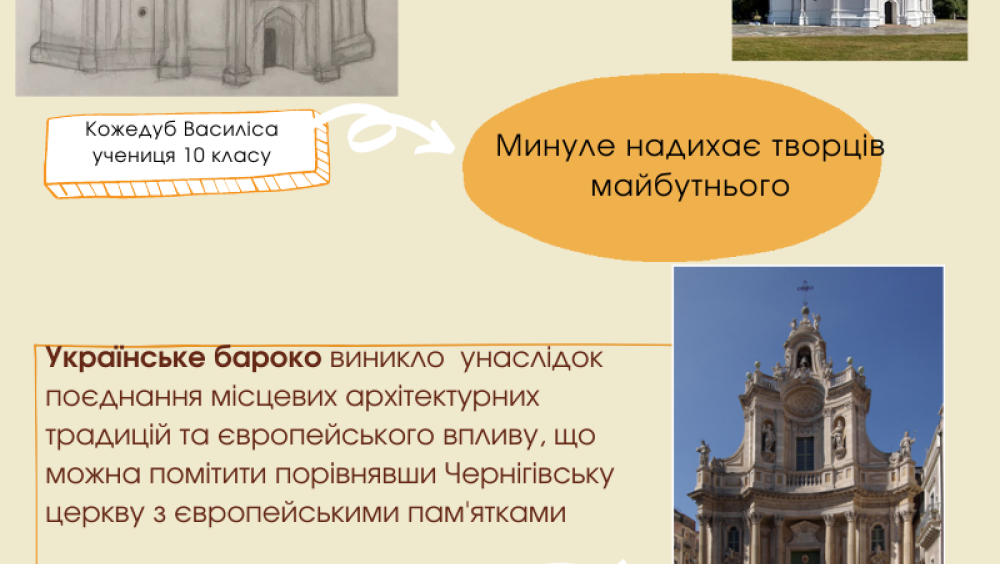Чернігів – європейське місто без бар’єрів та кордонів у часі та просторі /Chernihiv is a European city without barriers and borders in time and space
Спадщина – це все те, що залишилось нам від попередніх поколінь, все те, що становить можливість ідентифікувати себе як мешканців певного міста, регіону, країни, континенту.
Місто Чернігів, Україна, має чимало архітектурних пам’яток, які доводять нашу цивілізаційно-культурну єдність з Європою та її архітектурними традиціями. Чернігівські пам’ятки архітектури різних стилів на напрямків поєднують як класичні європейські архітектурні прийоми, так і містять унікальні зразки місцевих традицій у будівництві.
Наш проект направлено на дослідження учнями будівель Чернігова різних архітектурних стилів. Крім історичного дослідження щодо виникнення певного архітектурного стилю і Європі та на наших територіях, учні активно вивчали особливості архітектури та виконували власні ескізи будівель, щоб відчути стилістичні особливості та унікальність кожного стилю.
Проект представлено у вигляді плакатів-інфографіки, на яких розміщені назва архітектурного стилю, малюнки учнів, що проводили дослідження, описи особливості того чи іншого стилю, наведено приклади будівель даного типу у різних європейських містах.
Пам’ятки Чернігова вказані з географічними координатами, щоб будь хто міг знайти ці об’єкти та отримати доступ до інформації про них.
В проекті представлена дерев’яна архітектура. Адже в європейській будівельній традиції впродовж багатьох століть дерев'яне житлове будівництво мало провідну роль. Як для регіонів Центральної Європи так і на Чернігівщині дерев'яні будинки довгий час залишалися основними будівлями.
Чернігів славиться своїми дерев’яним мереживом - дивовижне мистецтво яке
переходить у спадок від покоління до покоління та є справжнім скарбом. Крім того, в місті ви можете без перешкод рухатися від одного будиночка до іншого, адже безбар’єрність у нашому місті – це зручні дороги, де ніщо не стає на заваді на вашому шляху.
Також у проекті досліджено пам’ятки бароко - поширений стиль у європейській архітектурі початку XVI століття - кінця XVIII століття. В цей же час виникає і Українське бароко, яке поєднало європейські та місцеві традиції.
Чернігів володіє унікальною пам’яткою неготичного архітектурного стилю. «Нова готика» виникла наприкінці 19 – на початку 20 століття на хвилі інтересу європейського суспільства до середньовічних традицій та набула популярності по всьому світу. Чернігівська пам’ятка яскраво демонструє всі особливості цього специфічного стилю.
У проекті також представлено архітектуру модерну. Даний стиль панував у архітектурі європейських країн на зламі 19-20 століть. Масова забудова вулиць та цілих районів створила нове архітектурне середовище в багатьох європейських містах. Чернігів не став винятком. Порівняння європейських зразків модернізму та пам’яток Чернігова ще раз доводить цивілізаційно-культурну спорідненість нашого регіону з Європою.
Heritage is all that is left to us from previous generations, all that is an opportunity to identify ourselves as inhabitants of a certain city, region, country, continent.
The city of Chernihiv, Ukraine, has many architectural monuments that prove our civilizational and cultural unity with Europe and its architectural traditions. Chernihiv architectural monuments of different styles combine both classical European architectural techniques and contain unique examples of local traditions in construction.
Our project is aimed at students of Chernihiv buildings to study different architectural styles. In addition to historical research on the emergence of a particular architectural style in Europe and in our territories, students actively studied the features of architecture and made their own sketches of buildings to feel the stylistic features and uniqueness of each style.
The project is presented in the form of infographic posters, which contain the name of the architectural style, drawings of students who conducted research, descriptions of the features of a particular style, examples of buildings of this type in different European cities.
Sights of Chernihiv are indicated with geographical coordinates so that anyone can find these objects and access information about them.
The project presents wooden architecture. After all, in the European building tradition for many centuries, wooden housing has played a leading role. For both the regions of Central Europe and the Chernihiv region, wooden houses have long been the main buildings.
Chernihiv is famous for its wooden lace - an amazing art, that is inherited from generation to generation and is a real treasure. In addition, in the city you can move freely from one house to another, because the barriers in our city are convenient roads where nothing gets in the way.
The project also explores the monuments of the Baroque - a common style in European architecture of the early XVI century - late XVIII century. At the same time, the Ukrainian Baroque emerged, combining European and local traditions.
Chernihiv has a unique monument of non-Gothic architectural style. "New Gothic" emerged in the late 19th - early 20th century on the wave of European society's interest in medieval traditions and gained popularity around the world. The Chernihiv monument vividly demonstrates all the features of this specific style.
The project also presents modern architecture. This style prevailed in the architecture of European countries at the turn of the 19th and 20th centuries. Mass construction of streets and entire districts has created a new architectural environment in many European cities. Chernihiv is no exception.
A comparison of European models of modernism and monuments of Chernihiv once again proves the civilizational and cultural kinship of our region with Europe.


